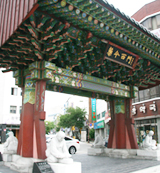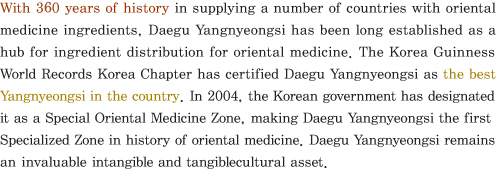Sub-menu area
SubBanner



Introduction to Yangnyeongsi
Yangnyeongsi was opened twice a year (once in the spring and once in the fall) in the year of 1658 (the 9th year of King Hyo-Jong) as a part of a national governance project to promote efficiency in collecting oriental medicine ingredients. Originally located at the backyard of an inn around the North Gate of the Daegu Castle, Yangnyeongsi was relocated to its current location in 1908 when the Daegu Castle walls were tore down by the Japanese sovereignty.
During Japanese occupation, Yangnyeongsi served as a place of communication for monetary supporters of the independence movement, and hence was subjected to suppression. In the end, in 1941, Yangnyeongsi was closed down, only to reopen after independence, but it was yet again closed down as a result of the Korean War. After the June 25th Incident of Korea, the permanent Oriental Medicine Market has developed into what is now Yakjeon (Pharmacopoeia) Alley around Namsung-ro.
Currently oriental medicine ingredient stores are distributed on a 715m-long sidewalk that crosses Namsung-ro, Dongsung-3-ga, Kyesan-1-ga, Kyesan-2-ga, Su-dong, Jongno-2-ga, Janggwan-dong and a proportion of Sangseo-dong. Officially, ‘Yangnyeongsi’ refers to the area where approximately 70-80% of such stores are concentrated in. Although the Ministry of Health & Welfare allocated 3654.9㎡ to establish the traditional oriental medicine market on August 1st, 1988, its boundary continues to grow due to an increase in the number of stores with similar merchandise. Daegu Yangnyeongsi is located in heart of the city where the Jungang-dae-ro and the Dalgubul-dae-ro intersect, and is easily accessible by public transportation. For example, both subway lines #1 and #2 are 2-3 minutes away from Yangnyeongsi by foot.
During Japanese occupation, Yangnyeongsi served as a place of communication for monetary supporters of the independence movement, and hence was subjected to suppression. In the end, in 1941, Yangnyeongsi was closed down, only to reopen after independence, but it was yet again closed down as a result of the Korean War. After the June 25th Incident of Korea, the permanent Oriental Medicine Market has developed into what is now Yakjeon (Pharmacopoeia) Alley around Namsung-ro.
Currently oriental medicine ingredient stores are distributed on a 715m-long sidewalk that crosses Namsung-ro, Dongsung-3-ga, Kyesan-1-ga, Kyesan-2-ga, Su-dong, Jongno-2-ga, Janggwan-dong and a proportion of Sangseo-dong. Officially, ‘Yangnyeongsi’ refers to the area where approximately 70-80% of such stores are concentrated in. Although the Ministry of Health & Welfare allocated 3654.9㎡ to establish the traditional oriental medicine market on August 1st, 1988, its boundary continues to grow due to an increase in the number of stores with similar merchandise. Daegu Yangnyeongsi is located in heart of the city where the Jungang-dae-ro and the Dalgubul-dae-ro intersect, and is easily accessible by public transportation. For example, both subway lines #1 and #2 are 2-3 minutes away from Yangnyeongsi by foot.
Hypotheses on the Origin of Yangnyeongsi

There are many hypotheses on how Daegu Yangnyeongsi came to establishment, and among them there are five main hypotheses: the Large City Hypothesis, the Chinese Tribute Hypothesis, the Japanese Export Theory, the Initiation of the Daedong Law Theory, and the Natural Establishment Theory.
First, the Large City Hypothesis says that Yangnyeongsi was established to serve as a hub for efficient collection of oriental medicine ingredients due to the need of the central and the provincial governments’ planning and monetary support. It maintains that Yangnyeongsi was meant to retain its big-city characteristics and play the role of a wholesale facilitator between the producers and the brokers. The Chinese Tribute Hypothesis states that within the context of Korea’s relationship with its neighbor countries, it is likely that Yangnyeongsi was an ingredient collection center for tributes to be made to China. The third hypothesis, the Japanese Export Theory is that Yangnyeongsi was developed in response to a growing demand of oriental medicine ingredients in Japan. This theory is supported by 大邱府史, published in 1943. Last is the Natural Establishment Theory, which states that the development of Yangnyeongsi was a circumstantial response to the initiation of the Daedong Law, which required all merchants to pay tribute to the Korean government in forms of products not money.
Yangnyeongsi also had geological advantages in growing herbs. With all of these in mind, one can guess that Daegu Yangnyeongsi served an important role not only domestically, but also internationally.
First, the Large City Hypothesis says that Yangnyeongsi was established to serve as a hub for efficient collection of oriental medicine ingredients due to the need of the central and the provincial governments’ planning and monetary support. It maintains that Yangnyeongsi was meant to retain its big-city characteristics and play the role of a wholesale facilitator between the producers and the brokers. The Chinese Tribute Hypothesis states that within the context of Korea’s relationship with its neighbor countries, it is likely that Yangnyeongsi was an ingredient collection center for tributes to be made to China. The third hypothesis, the Japanese Export Theory is that Yangnyeongsi was developed in response to a growing demand of oriental medicine ingredients in Japan. This theory is supported by 大邱府史, published in 1943. Last is the Natural Establishment Theory, which states that the development of Yangnyeongsi was a circumstantial response to the initiation of the Daedong Law, which required all merchants to pay tribute to the Korean government in forms of products not money.
Yangnyeongsi also had geological advantages in growing herbs. With all of these in mind, one can guess that Daegu Yangnyeongsi served an important role not only domestically, but also internationally.



.jpg)





